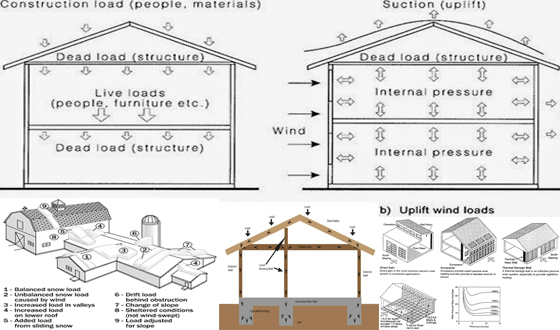Categories of loads on the building structures

The loads are generally categorized as vertical loads, horizontal loads and longitudinal loads. The vertical loads contain dead load, live load and impact load.
The horizontal loads include wind load and earthquake load. The longitudinal loads alias tractive and braking forces may be taken into consideration occasionally for designing bridges, gantry girders etc.
1. Dead load: Dead loads refer to stable or stationary loads which are transmitted to structure during the entire life. Dead load mainly occurs owing to self weight of structural members, perpetual partition walls, fixed permanent equipments and weight of various materials.
2. Imposed loads or live loads: Live loads refer to transferrable or moving loads devoid of any acceleration or impact. The loads are generated with the anticipated application or possession of the building along with weights of transferrable partitions or furniture etc. The floor slabs should be designed with the intension of bearing either equally distributed loads or concentrated loads whichever create superior stresses in the part to be decided. Since it is doubtful that all floors will not be bearing extreme loading all at once on any specific time, the code allows some curtailment in imposed loads in designing columns, load bearing walls, piers supports and foundations.
3. Impact loads: Impact load results from vibration or impact or acceleration. Therefore, impact load is similar to imposed load. Some percentage like impact factor or impact allowance can expand the impact load on the basis of the intensity of impact.
4. Wind loads: Wind load refers to horizontal load that takes place due to the air transition to earth. Wind load should be included in the design specifically when the heath of the building surpasses twice the dimensions transverse to the uncovered wind surface.

Ref.: theconstructor.org
For short structured building like four to five storied, the wind load does not become complicated as the moment of resistance supplied by the continuity of floor system to column connection and walls extended among columns are abundant to suit the consequence of these forces. Moreover, in limit state method, the factor for design load is minimized to 1.2 (DL+LL+WL) as soon as the wind is assessed as against the factor of 1.5(DL+LL) when wind is inconsiderate. IS 1893 (part 3) code book should be applied for the intention of design.
5. Earthquake load: Earthquake loads belong to horizontal loads which are delivered due to the earthquake and calculated compliant with IS 1893. For monolithic reinforced concrete structures situated in the seismic zone 2, and 3 devoid of more than 5 storied high and importance factor not more than 1, the seismic forces are considered as critical.
|